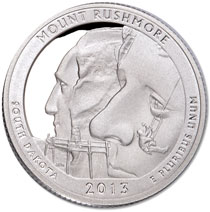
Mount Rushmore National Memorial quarter design
On December 10, 2012, the U.S. Mint revealed the final design for the Mount Rushmore National Memorial quarter – fifth and final new 2013 quarter design and 20th issue overall in the 2010-2021 National Park series.
The reverse for the 2013 Mount Rushmore Quarter was inspired by photos of workers adding final details to the presidential images. The design offers a unique educational perspective on how the Mount Rushmore sculpture was created, and illuminates the challenges and difficulties of the construction project which including fundraising delays spanned over 14 years from 1927-1941. Inscriptions on the reverse include mount rushmore, south dakota, e pluribus unum and the date of issue 2013.
The final design was selected from several candidate designs by the Secretary of the Treasury, after review by the Secretary of the Interior, the governor of South Dakota, the Commission of Fine Arts, and the Citizens Coinage Advisory Committee. The 2013 Mount Rushmore quarter will be an exciting complement to the 2006 Statehood Quarter featuring the memorial’s home state of South Dakota.
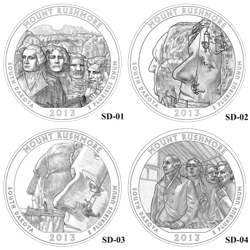
Candidate designs for the Mount Rushmore National Memorial Quarter
In the fall of 2011, the Citizens Coinage Advisory Committee and the Commission of Fine Arts reviewed candidate designs for the 2013 Mount Rushmore National Memorial Quarter. Design proposals SD-02 and SD-03 featured the sculpture under construction with wooden staging and with workmen in bosun chairs suspended from steel cables. Candidate design SD-01 offered an aerial view of the completed sculpture, while proposal SD-04 depicted the scale model of the sculptor’s original intended design now on display in the Sculptor’s Studio on the memorial grounds.
The reviewing organizations expressed great interest in representations of the sculpture’s construction, as the project took many years of perilous work on granite cliffs hundreds of feet above the valley floor. The Mount Rushmore sculpture had been an extraordinary engineering feat, requiring hundreds of workers on staging and in harnesses using dynamite, jackhammers, pneumatic drills, stone chisels and other tools.
After careful consideration, the Commission of Fine Arts recommended proposal SD-03 as the “strongest design” – representing construction of the mountain sculpture without being too busy or complex.
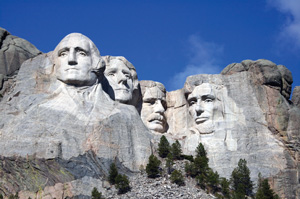
Mount Rushmore National Memorial
Featured on the 20th issue of the 2010-2021 National Park Quarter series, the Mount Rushmore National Memorial is a colossal mountain sculpture in the Black Hills of South Dakota. Completed in 1941, the memorial features 60-foot images of four U.S. presidents chosen for their roles in the “foundation, expansion and preservation” of the nation:
- George Washington commanded the Continental Army during the American Revolution and served as first U.S. president
- Thomas Jefferson doubled the size of the country with the Louisiana Purchase
- Abraham Lincoln preserved the Union during the dark days of the Civil War
- Theodore Roosevelt completed the Panama Canal, linking eastern and western parts of the country by water
The memorial grounds comprise over 1,278 acres and include a Visitor Center, the Lincoln Borglum Museum featuring construction exhibits, and the Sculptor’s Studio containing Gutzon Borglum’s original scale model. The Avenue of Flags leads to the Grandview Terrace, and to the Presidential Trail offering majestic close-up views of the sculpture.
Each year, nearly three million people visit the Mount Rushmore National Memorial – known as the “Shrine of Democracy” and one of America’s most cherished tributes to freedom.
More information on Mount Rushmore National Memorial.
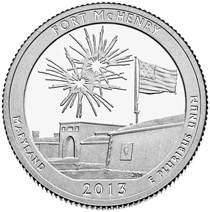
Fort McHenry National Monument and Historic Shrine quarter design
The final design for the 2013 Fort McHenry National Monument and Historic Shrine quarter was announced by the U.S. Mint on December 10, 2012. The reverse of the Fort McHenry quarter will feature a scene from Defenders Day – the centerpiece annual event recalling the fort’s defense of Baltimore Harbor in the War of 1812 against Great Britain. Depicting the fort and a 15-star flag as flown during that conflict, Defenders Day fireworks represent “the bombs bursting in air” that inspired Francis Scott Key to write a poem during the War of 1812 that became our national anthem as The Star-Spangled Banner.
Inscriptions on the reverse include fort mchenry, maryland, 2013 and e pluribus unum. This is the 19th design in the popular quarter series which, from 2010-2021, is honoring a national park or historic site in each of the 50 states, the District of Columbia, and the 5 U.S. territories.
This eye-catching quarter will be a perfect match for the 2000 Statehood Quarter featuring Maryland, the home state of Fort McHenry – revered birthplace of our national anthem. This fourth 2013 design will be followed by a fifth and final 2013 design honoring Mount Rushmore National Memorial in South Dakota.
After four original design proposals for the 2013 Fort McHenry National Monument and Historic Shrine quarter were rejected by the Commission of Fine Arts (CFA) as well as the Citizens Coinage Advisory Committee (CCAC), a second round consisting of 11 proposals (shown here) was presented by the U.S. Mint design staff.
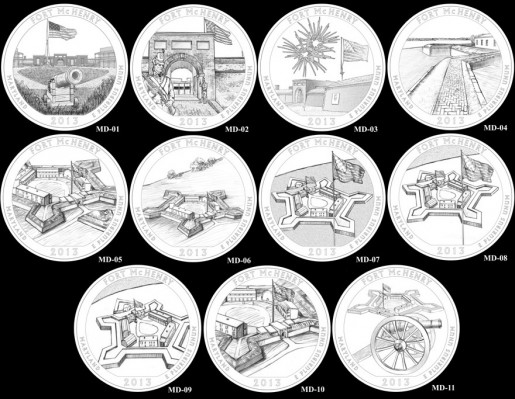
Candidate designs for Fort McHenry National Monument and Historic Shrine quarter
While the first round of designs featured Fort McHenry soldiers from the War of 1812, the second series of designs focused on the fort itself as requested by the CFA after the first presentation. Seven of these proposals display aerial views of the star-shaped structure, while three highlight in turn a cannon and the inner courtyard, the prominent arched entrance, and the fortified outer wall. One design illustrates a prominent line from The Star Spangled Banner – written by Francis Scott Key in view of Fort McHenry in 1814 – “…and the rockets red glare, the bombs bursting in air…”
Famous as the “birthplace of our national anthem”, Fort McHenry is visited by thousands of people each year, and was a popular featured site for the Maryland issue of the National Park Quarter Series.





